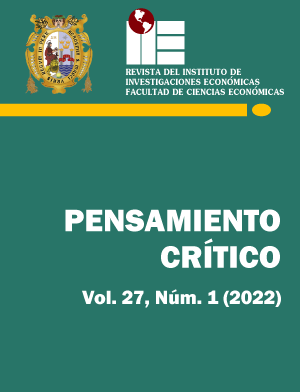Efficiency of health in the regions of Peru, 2012-2019
DOI:
https://doi.org/10.15381/pc.v27i1.23273Keywords:
technical efficiency, health spending, health economics, PeruAbstract
During the COVID-19 pandemic, Peru positioned itself as the country with the highest mortality rate per 100,000 inhabitants worldwide. This fact made evident, among other factors, the limitations of the health system, especially in the interior of the country. Therefore, under a production function approach, the efficiency rates were estimated for the 24 regions in a pre-pandemic period, to show existing gaps, both in inputs and in health outcomes. Methodology: application of a parametric method of stochastic frontiers, model Battese and Coelli (1988), considering health care as the outcome variable and capital, labor and public spending as inputs. In addition, a reference country (the United States) is incorporated to measure the efficiency gaps. Results: the efficiency index of the United States is equal to 1, proving to be a frontier; the average efficiency of the regions of Peru is 0.70; the most efficient region is Ayacucho (0.95) it achieves greater production with less inputs while the least efficient is Moquegua (0.23).
Downloads
Published
Issue
Section
License
Copyright (c) 2022 Fabiola Moreno Jaime

This work is licensed under a Creative Commons Attribution-NonCommercial-ShareAlike 4.0 International License.
THE AUTHORS RETAIN THEIR RIGHTS:
a. The authors retain their trademark and patent rights, and also on any process or procedure described in the article.
b. The authors retain the right to share, copy, distribute, execute and publicly communicate the article published in Pensamiento Crítico (for example, place it in an institutional repository or publish it in a book), with recognition of its initial publication in Pensamiento Crítico.
c. The authors retain the right to make a subsequent publication of their work, to use the article or any part of it (for example: a compilation of their works, notes for conferences, thesis, or for a book), provided they indicate the source of publication (authors of the work, journal, volume, number and date).






